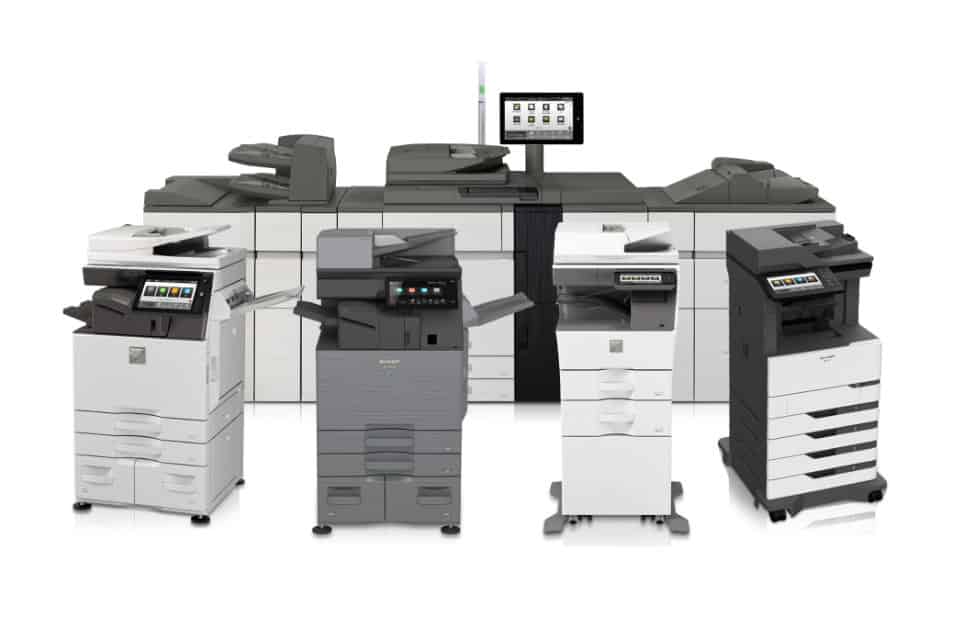When your business is in the market for a new copier, evaluating proposals can be a daunting task. The right copier can enhance productivity and streamline operations, while the wrong choice can lead to frustration and increased costs.
But if you’re not constantly working in the copier industry, there’s probably a lot that you don’t know. That’s fair, and why managed print experts exist today. So I am going to provide you with seven key factors to consider when evaluating copier proposals. By working through this information, you will surely make an informed decision.
Table of Contents
Copier Specifications
Understanding the specifications of the copier is crucial in determining if it will meet your business needs. It’s not uncommon for a sales person to propose a MFP that offers lesser specs in an attempt to come in as the low bid. If the printer still meets your needs or budget is your biggest priority, that’s fine. But if they’re proposing a copier that doesn’t meet your needs, you’re often better off looking at the better alternatives.
Print Speed
Look at the pages per minute (PPM) rating, which indicates how fast the copier can print. Consider whether you need high-speed printing for large volumes or if lower speeds will suffice for your typical workload.
Now keep in mind that print speed is only part of the equation. You also have to look at how large your print jobs are, and how often you print.
If you’re only printing small documents, print speed matters a lot less. A 3 page document on a 28PPM copier comes out as fast as 6 seconds. A 3 page document on a 60PPM copier comes out as fast as 1.5 seconds. Does 4.5 seconds make a difference in your day? For many users, it does not. They’ll hit print and pick up the document when they get around to that area. Or they’ll move to the copier ASAP and that often takes more than 4.5 seconds.
If you’re printing large documents, print speed is a huge deal. Back in my insurance accounting days, we would essentially print a book for month end close. It was roughly 1,200 pages. We made 4 copies. And it could only happen after the last of the day’s business was completed (ie, early evening). That 28PPM copier would take nearly 3 hours. A 60PPM copier would run the print job less than 1.5 hours.
For larger churches printing bulletins, speed can also be very important. Consider a tabloid sheet (11″x17″) turned into a booklet creates 4 images, and you need to account for time to flip the paper for duplexing. A sheet on that 28PPM is probably going to take 15 seconds. On the 60PPM copier that same sheet might take 6 seconds. A faster copier with better finishing options can easily save hours of labor every week. Even though it costs more on the lease, it can save printing costs and a significant amount of labor. The more expensive copier can often be cheaper to run over time.
Print Quality
The DPI (dots per inch) measure will tell you the print resolution. Higher DPI means better quality, which is essential for producing professional documents. For typical office use, 600×600 dpi is just fine. But if you’re producing high value proposals or marketing materials, you might want a copier that offers 1200×1200 dpi.
Another quality check relates to color. Every printer out there (even printers of the same model) will render colors just a little different than the others. This is especially easy to see in skin tones. To ensure proper color output, the printing industry has standardized on the Pantone color system. Some copiers offer integration with a Fiery controller to provide exceptional color matching of properly prepared documents. Others offer what is called “Pantone matching” capabilities. In this instance, the manufacturer has specified precise toner blends against a reference color. This works pretty well, offering minimal color drift across a print job, and is significantly cheaper than buying a Fiery. Some copiers, however, simply offer “business color” capabilities. These color printers are fine for day to day output, but they’re definitely a step below a Pantone matching system and two steps below using a Fiery.
Paper Handling
Check the paper sizes the copier can handle and the tray capacity. Features like duplex printing (automatic double-sided printing) can save paper and time. If you never print tabloid paper, look at the available A4 copiers, which are usually less expensive up front. If you have to print on particular kinds of paper stock, make sure the MFP is rated to use it. Sometimes you find a need for using especially thick paper stock.
Volume Capacity
Copiers are rated with a monthly duty cycle, which indicates the maximum number of pages the copier can handle per month. At this sustained volume, you should expect a major service call about once a month.
Think of this number like a car maintenance schedule. That timing belt might be rated for 150,000 miles. It will probably run for some time beyond that, if you don’t replace it right away. But the longer you go, the more likely you are to have a catastrophic problem while driving down the road.
Now would you buy a car that needed a new timing belt every month? Heck no! You’d probably call the car an unreliable piece of junk on days you felt especially kind.
So look for a monthly duty rating that approximates your annual printing needs for that particular device. A major part replacement or PM service annually isn’t that bad.
Cost and Budget Considerations
Evaluating the financial aspect is not just about the initial price tag.
Initial Purchase Price
While the upfront cost is important, it’s just one part of the equation. If you see a major outlier between proposals, you need to figure out why that is the case.
Total Cost of Ownership
Factor in long-term costs such as maintenance, supplies (toner, paper), and energy consumption. A cheaper copier might end up costing more over time.
Lease vs. Buy
Consider the pros and cons of leasing versus purchasing outright. Leasing can offer lower upfront costs and flexibility to upgrade, while buying might be more cost-effective in the long run.
Financing Options
Explore available financing plans, interest rates, and terms to determine the most affordable way to acquire the copier.
Maintenance and Support
Reliable maintenance and support are essential for minimizing downtime and keeping the copier running smoothly. Many of our new customers end up leaving their old copier company early because of poor service and high costs.
Service Contracts
Review the details of service agreements, including response times and what is covered. Ensure the vendor offers timely and efficient service. A well run copier company should be able to resolve most service issues on the same day.
Warranty Coverage
Understand the duration and extent of the warranty. Know what is included and what is excluded to avoid unexpected expenses.
Technical Support
Ensure customer support is readily available, with options for remote diagnostics and troubleshooting.
Maintenance Costs
Be aware of the costs for regular maintenance and repairs. Predictable maintenance costs can help with budget planning.
Some companies will try to place you into a pre-paid volume band. They essentially over-sell you prints to ensure you don’t receive a “surprise bill” later. But here’s the trick – any prints you don’t make will be pure profit for them and increase your actual cost per print.
Other dealers, like Inacom, bill from 0 each month. You only pay for the prints you make during the period. That’s a more fair way to do business, don’t you think? Remember COVID, when offices everywhere were shuttered? Many companies were paying through the nose for prints they never made. Ouch!
Vendor Reputation and Reliability
The reputation and reliability of the vendor are as important as the copier itself.
Vendor History
Research the company’s background and how long they’ve been in business. A well-established vendor is often more reliable.
Customer Reviews
Look for feedback from existing clients and read testimonials. Real-world experiences can provide valuable insights.
References
Ask the vendor to provide references from similar businesses. Talking to current customers can help you gauge satisfaction levels. Be sure references have been with the provider for at least a few years – the honeymoon effect is real.
Accreditations
Check for certifications and industry recognitions that attest to the vendor’s credibility and commitment to quality. Consider that today’s copiers are network connected. You might want a copier company that is also a Microsoft Partner and an expert supporting Microsoft 365 on your side.
Contract Terms
Carefully review the contract terms to avoid any unpleasant surprises down the line.
Length of Contract
Understand the duration of the agreement and renewal terms. Ensure it aligns with your business needs.
Termination Clauses
Know the conditions under which the contract can be terminated. Flexibility here can be crucial if your needs change.
Service Level Agreements (SLAs)
Look for performance guarantees and penalties for non-compliance. SLAs ensure the vendor is accountable for maintaining service standards.
Upgrade Options
Check if there is flexibility to upgrade equipment during the contract term. This can be important if your business grows or your needs change.
Technology and Features
Modern copiers come with various technological advancements and features that can enhance efficiency and security. Years ago, network printing was the killer feature. Today’s copiers focus on application integration and security. Can your MFP support firmware updates and run antivirus software?
Connectivity
Ensure the copier has network capabilities, including wireless printing and compatibility with mobile devices. This can streamline printing processes.
Software Integration
Check if the copier is compatible with your existing software and document management systems. Integration can simplify workflows.
Security Features
Data encryption, user authentication, and secure print release are vital for protecting sensitive information.
Energy Efficiency
Look for energy-efficient MFPs with features like power-saving modes and Energy Star ratings. This can reduce operational costs and environmental impact.
Deployment and Installation
The vendor’s ability to deploy the print solution effectively is critical to avoid additional burdens on your IT department.
Installation Services
Ensure the vendor offers comprehensive installation services. This includes physical setup, print drivers, and network integration.
Network Integration
The vendor should assist with integrating the copier into your existing network, ensuring it works seamlessly with your infrastructure. Will your copier dealer handle print drivers, or is it up to your IT service provider to do the job?
Configuration Support
Look for support in configuring the copier for optimal performance, including setting up user preferences and workflows. Your new vendor should be able to help you pre-program address books, configure print drivers for specific print jobs, and provide opportunities to streamline workflows.
Training
Onsite training for staff ensures they can effectively use the new copier, maximizing its potential from day one.
Post-Installation Support
Ensure there is support available immediately after installation to address any issues that arise.
By carefully evaluating these factors, you can select a copier that not only meets your immediate needs but also supports your business’s long-term goals. Make an informed decision to enhance productivity, manage costs, and ensure smooth operations.

